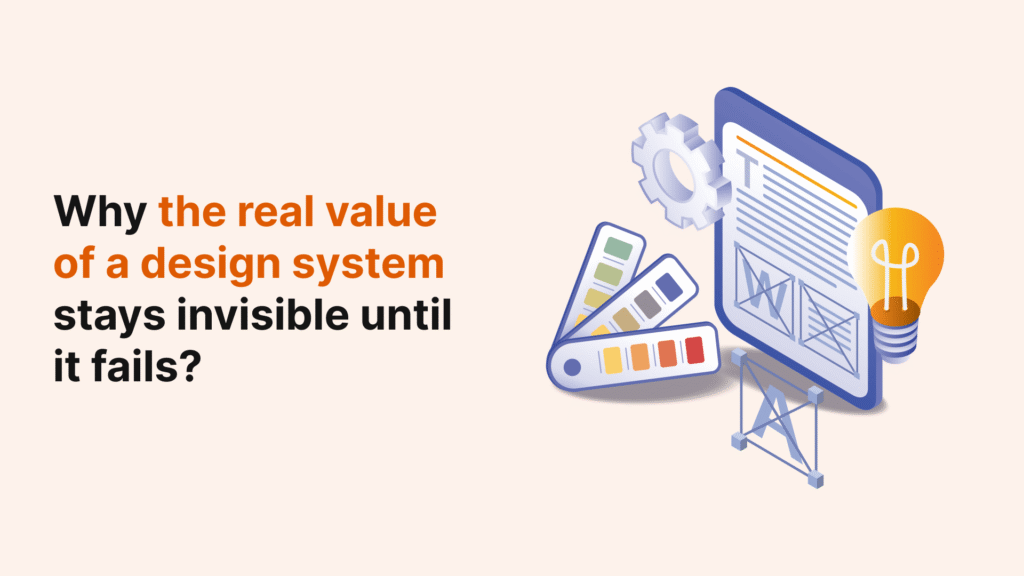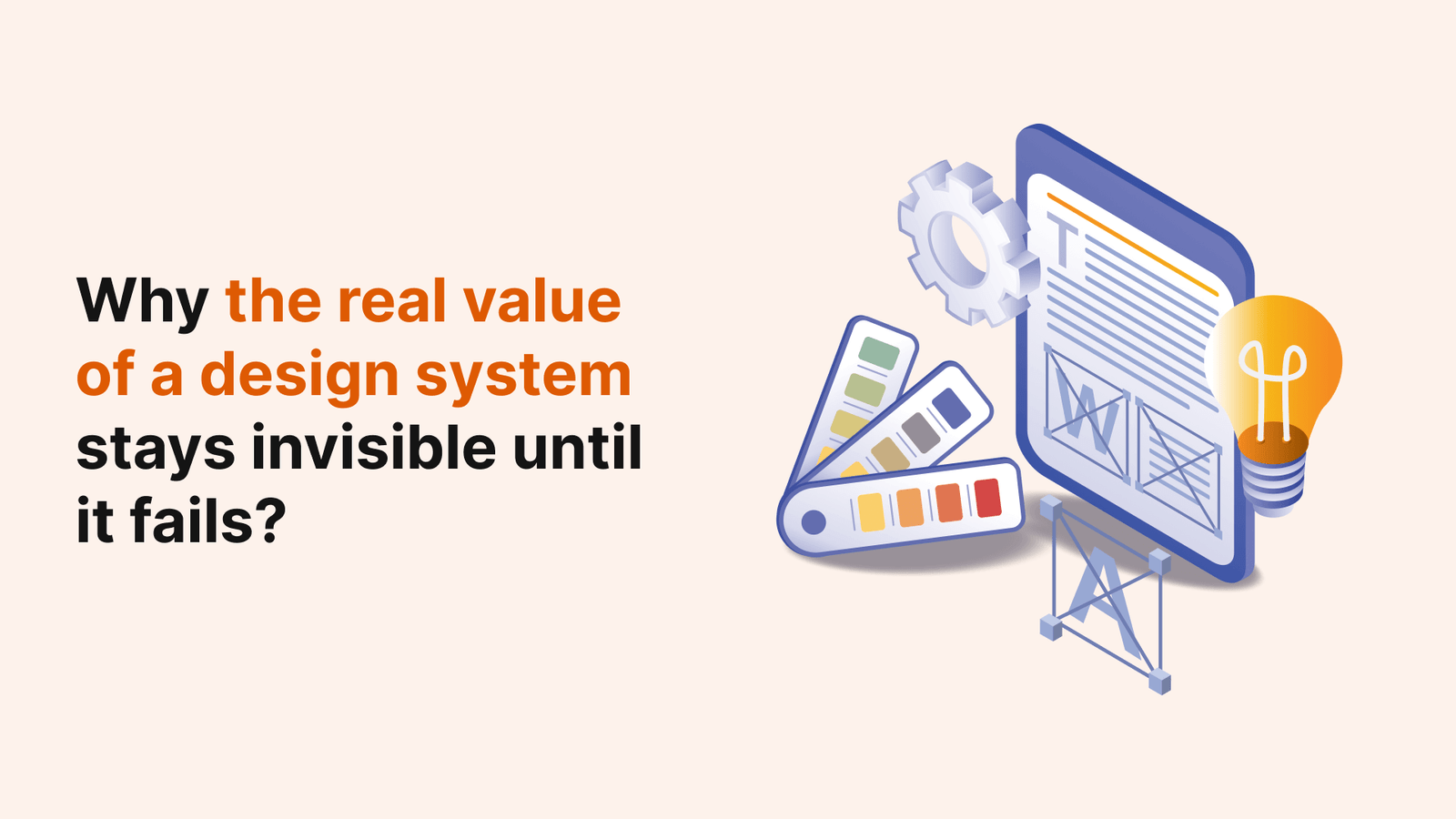A design system silently powers your product experience until suddenly it doesn’t. Design debt builds up quietly in the background, causing development to slow down and quality to slip. We often don’t appreciate the true value of these systems until inconsistencies emerge and teams find themselves fixing the same issues multiple times in different ways.
Without a design system, teams quickly find themselves in a crisis of inconsistency—navigating a maze where every turn leads to confusion, brand dilution, or user frustration. What is a design system exactly? At its core, it’s a single source of truth that reduces redundancy and accelerates development. Unfortunately, many organizations struggle with design system implementation not because of technical challenges, but because of adoption issues across teams. In fact, treating your design system like a product rather than a side project is essential for success. As we explore what design system means in UI/UX contexts and examine design system examples, we’ll uncover how these frameworks silently enable consistency and scalability while streamlining both design and development processes.
What is a design system in UI/UX context?
In the realm of digital product development, a design system serves as a comprehensive blueprint that standardizes design at scale. It consists of reusable components guided by clear standards, enabling teams to build consistent digital experiences across various platforms. Unlike other design resources, a design system is living and evolving—continuously adapting to meet changing product needs and user expectations.
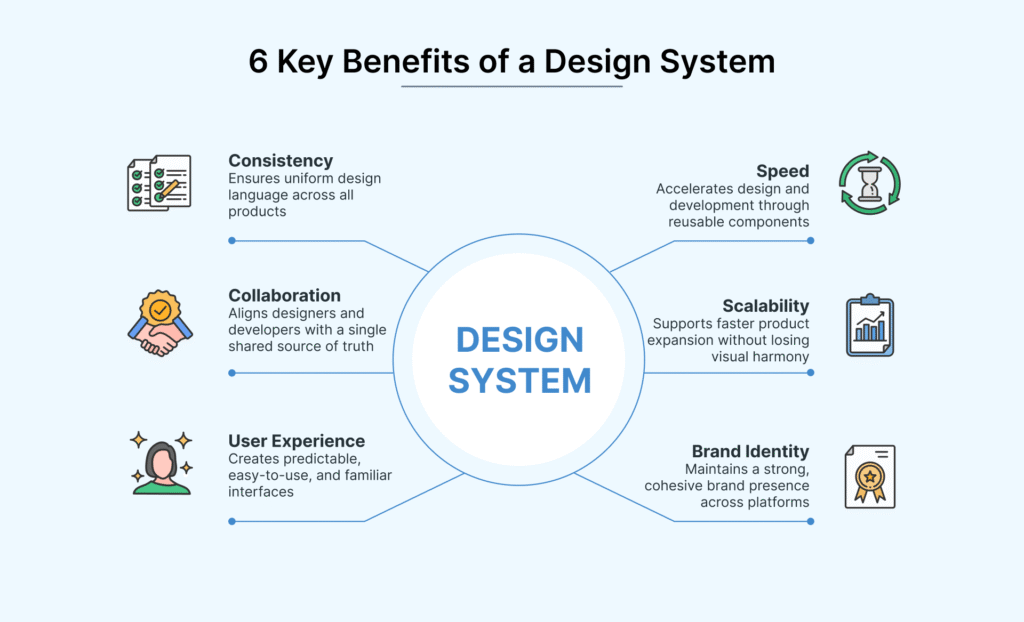
Design system vs style guide vs component library
Though often confused, design systems, style guides, and component libraries serve distinct purposes. A design system encompasses everything—it’s the master plan for creating cohesive product experiences. It includes reusable UI elements, interaction patterns, design principles, and detailed documentation that together form a unified language for product teams.
A style guide, however, represents just one piece of the design system puzzle. It primarily focuses on visual references and implementation guidelines—covering aspects like typography, colors, and logo usage. As one document within the broader design system framework, a style guide typically addresses specific style needs such as:
- Content style: Guidelines for tone of voice, grammar, and formatting rules
- Brand style: Color palettes, typography, logos, and imagery standards
- Visual style: User interface elements and their usage guidelines
Component libraries, alternatively, serve as repositories of reusable UI elements like buttons, menus, and input fields. Each component includes specifications such as:
- Component name and description
- Customizable attributes (size, color, shape)
- Various states (enabled, hover, focus)
- Code snippets for implementation
Pattern libraries extend beyond individual components to feature collections of UI element groupings and layouts—essentially showing how components work together in common scenarios.
Why design systems are more than just Figma files?
Design systems transcend the boundaries of design tools. Although Figma certainly functions as a foundational tool where designers create UI kits and templates, a true design system represents something more profound—a culture of coherence that persists release after release.
The strength of a design system lies not merely in its visual documentation or component library, nevertheless in its ability to provide:
- Clarity on when to use specific patterns
- A framework for consistent decisions across teams
- A living guide that evolves alongside products and brand identity
Furthermore, design systems establish a shared design language between design and development teams. This common vocabulary enables different departments within an organization to work independently yet produce cohesive results. For instance, design teams working in separate departments can utilize components from the same design system, consequently ensuring their outputs maintain consistency despite being created independently.
The impact extends to development teams as well. Instead of coding elements from scratch repeatedly, developers can reference and implement existing components from the design system—dramatically increasing efficiency. This collaboration between designers and developers transforms the product development lifecycle, resulting in faster time-to-market and more unified user experiences.
A mature design system requires proper governance and maintenance. Without continuous oversight, even the most carefully crafted system risks becoming outdated. This highlights perhaps the most significant distinction between a mere collection of design files and a true design system: the human element—the people who manage, update, and champion its use throughout an organization.
The invisible value of design systems
Behind every polished digital experience lies an often overlooked hero: the design system. Its greatest value remains invisible to users—yet becomes glaringly apparent once it fails.
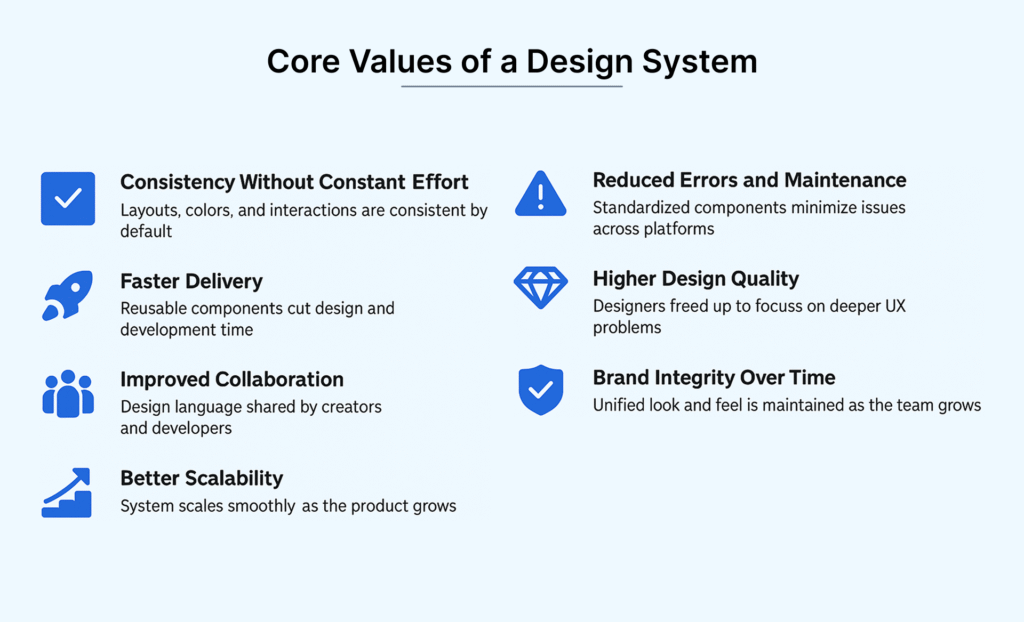
How design systems reduce decision fatigue?
Design decisions drain our mental energy more than we realize. Software developers collectively write millions of lines of new code daily, facing a constant barrage of choices that gradually depletes their mental reserves. This phenomenon, known as decision fatigue, eventually leads to the “let’s just go with this and I’ll fix it later” mindset—a dangerous trap in product development.
A robust design system combats this fatigue by eliminating unnecessary choices. When designers and developers have standardized components, guidelines, and patterns at their disposal, they preserve mental energy for solving complex problems. Moreover, this preservation of cognitive resources allows teams to:
- Focus on innovation rather than recreation
- Maintain creative energy throughout projects
- Make more intentional design decisions
As one industry expert puts it, “Design by Decision Fatigue” shapes our software based on choices made under mental constraint. A well-implemented design system prevents this by establishing clear defaults and reducing the mental tax of repetitive decisions.
Consistency and scalability as silent enablers
The true power of design systems lies in their ability to enhance consistency and enable growth without corresponding increases in complexity or team size. As products expand, a design system prevents the exponential rise in effort typically required to maintain quality across features.
Design systems serve as silent enablers by providing a modular foundation that grows alongside your product. The scalable nature allows for efficient expansion without sacrificing user experience quality. Additionally, these systems help future-proof design work through standardized approaches that adapt to changing needs.
From a business perspective, design systems deliver substantial yet often unseen value: they allow companies to build more products without exponentially increasing their teams. This works through the centralization of design decisions and alignment—creating a foundation that supports growth without corresponding increases in overhead.
Design system examples that quietly power products
Many successful products rely on design systems that work tirelessly behind the scenes. Consider these examples that silently enable consistent experiences:
Shopify Polaris offers comprehensive UI components, content guidelines, and accessibility standards—all focused on building consistent e-commerce experiences. Through this unified approach, Shopify maintains coherence across its complex ecosystem.
Pinterest’s Gestalt system enhances every aspect of user experience by promoting consistency, scalability, and accessibility across its visually rich platform. This enables both internal teams and external partners to create cohesive interfaces aligned with Pinterest’s visual discovery mission.
Capital One’s design system ensures consistency, scalability, and accessibility throughout its digital financial services, enabling designers and developers to create seamless, secure experiences for millions of customers.
IBM’s Carbon Design System features an extensive component library, robust accessibility standards, and thorough documentation—covering design, front-end code, and best practices.
Each of these examples demonstrates how design systems quietly facilitate product development while remaining largely invisible to end users. Their value becomes truly apparent only when inconsistencies emerge or development processes break down.
Why most design systems fail silently?
Many design systems collapse without fanfare—their failure not marked by dramatic crashes but by quiet abandonment and gradual irrelevance. These silent failures often stem from fundamental issues in how organizations approach design system development and implementation.
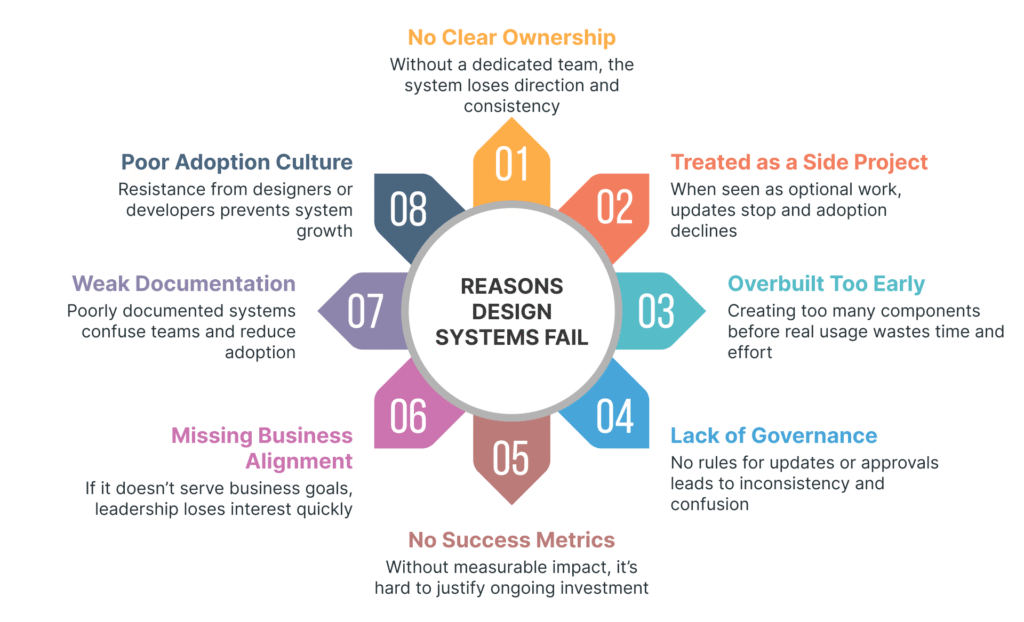
No clear business goal or success metric
Design systems frequently fail due to poorly defined success criteria. Setting meaningful metrics represents one of the most challenging tasks for teams implementing design systems. Many organizations struggle with identifying what truly matters—should they track visual consistency, development speed, or something else entirely?
Too often, teams focus exclusively on esthetic refinements or technical aspects without connecting these efforts to business outcomes. As one design expert notes, “What good does it do to have perfect UX in 5% of the app, if the remaining 95% never get a chance to experience it?” This disconnect between design efforts and business goals leads to inefficiencies that slow down product development.
The primary mistake involves viewing UI/UX refactoring as valuable in itself rather than tying it to customer needs or willingness to pay. Subsequently, organizations fail to prioritize metrics that demonstrate real impact, such as:
- Increased team velocity
- Improved product maintainability
- Faster time-to-market
- System adoption rates
- Cross-departmental collaboration
Without these measurable outcomes, design systems become abstract initiatives difficult to justify to stakeholders. Additionally, companies often underestimate how open-ended UX enhancement can be—it’s a project with ill-defined boundaries that’s difficult to declare complete. This ambiguity makes it hard to demonstrate progress or justify ongoing investment.
Design system seen as a side project
Perhaps the most pervasive reason design systems silently crumble is their treatment as side projects rather than critical infrastructure. Initially promising initiatives fade away because nobody owns them fully. According to industry research, the success rate plummets when design systems lack dedicated resources.
Typically, what occurs is that a passionate advocate champions the design system alongside their primary responsibilities. This arrangement works temporarily until competing priorities inevitably arise. As one expert describes: “Often what happens is that the champion for the system is also a key part of another product sector or project and has to create and support it as a part-time gig”.
This part-time approach creates several fundamental problems:
- Inconsistent progress as contributors get pulled to other projects
- Difficulty maintaining momentum through design system iterations
- Lack of accountability for results and outcomes
- Inability to respond promptly to feedback from users
Even worse, occasionally the “team” consists of a large group randomly contributing bits and pieces without clear ownership or decision-making authority. This distributed, unfocused effort practically guarantees failure. Without dedicated resources who are aligned on purpose and empowered to make organizational decisions, design systems gradually drift into irrelevance.
Organizations generally fall into this trap because they become enamored with the idea of having a design system without allocating the necessary resources. They treat it as a one-time project rather than an ongoing product requiring consistent maintenance and evolution. Unfortunately, this mindset ultimately produces fragmented experiences—precisely what design systems aim to eliminate.
When things go wrong: how failure reveals the system?
The true value of a design system becomes painfully obvious only when things fall apart. Like oxygen, we notice its absence more than its presence. The failures that emerge are often the first visible signs of deeper systemic issues that have been brewing beneath the surface.
Inconsistent UI patterns across teams
The breakdown of design consistency often occurs gradually yet visibly. Even with talented designers, components may be used differently across various contexts, creating subtle inconsistencies that users immediately notice. Teams frequently struggle not because they lack skill, yet because they lack structure. Without a robust design system, small inconsistencies accumulate rapidly—buttons appear slightly different across screens, spacing feels off, and the product slowly loses its visual identity.
Throughout implementation, designers may resist adopting standardized approaches, preferring unique designs over system-dictated patterns. As one implementation story reveals, designers weren’t accustomed to working with nested components, naming conventions, or consistent layer styles, causing them to bypass fundamental principles the design system relied upon.
Delayed product launches due to missing components
Product launch delays represent one of the most costly design system failures. Research shows that 45% of all product launches are delayed by at least one month, with technical documentation issues ranking among the top causes. Indeed, 90% of engineering leaders admit to delaying launches specifically due to late-stage design changes.
Meanwhile, these delays create cascading problems. Rather than focusing on production, teams find themselves debugging the system and producing emergency fixes. The financial impact extends far beyond immediate revenue loss—customer relationships suffer, competitive positioning weakens, and long-term market share erodes.
Accessibility issues from ungoverned design changes
Accessibility failures often emerge when design systems lack proper governance. Without clear guidelines and oversight, teams unknowingly introduce barriers that exclude users with disabilities. Based on World Health Organization data, inaccessible designs exclude approximately 15% of the global population.
Prior to experiencing consequences, many teams overlook accessibility requirements. Nonetheless, the repercussions extend beyond ethical concerns to legal ones—many jurisdictions, including the EU, have penalties for inaccessible designs.
Accessibility testing requires both automated and manual approaches. While automated tools identify common issues like missing alt text, they cannot detect all problems, hence making human testing essential. A properly maintained design system serves as the first line of defense against accessibility failures by embedding standards directly into components.
Common reasons design systems fail
Even well-intentioned design systems often collapse under the weight of predictable pitfalls that companies repeatedly encounter. Understanding these common failure points helps teams avoid the same traps that have claimed countless design systems before them.
Lack of shared purpose and ownership
Design systems frequently fail without a clear, contextual sense of purpose that aligns all stakeholders. Amy Hupe, in her 2022 Clarity Conference talk “Down with Design System Dogma,” emphasized the importance of teams aligning on purpose before creating outputs. She pushed teams to think beyond standard promises like consistency, efficiency, and scale to understand what makes their specific organization’s needs unique.
Ambiguous ownership structures typically undermine otherwise promising initiatives. Organizations often make the critical mistake of expecting quality output without dedicated resources:
- Part-time contributors with competing priorities
- Random contributions from multiple people without clear decision authority
- Champions who must support the system alongside their primary roles
As Josh Franklin notes: “Often what happens is that the champion for the system is also a key part of another product sector or project and has to create and support it as a part-time gig”. This approach virtually guarantees a gradual drift toward irrelevance.
Overbuilding before real usage
Many teams build elaborate design systems without first validating their approach through smaller experiments. This “overbuilding” represents perhaps the cardinal sin of product development—creating something comprehensive before confirming users actually need it.
The Pareto principle applies particularly well here: a focused design system that supports the right 20% of user experiences can drive 80% of business outcomes, provided teams carefully consider their purpose. Starting small allows for contextual component development, gradual introduction of changes, and incorporation of feedback when it matters most.
No clear governance or contribution model
Without proper governance, design systems become vulnerable to power struggles, inconsistent implementation, and eventual abandonment. Team members might call on executive power to push or block design changes, overriding initial decisions of the design system team.
Contribution models frequently fail when organizations attempt to create a one-size-fits-all approach. As Brad Frost notes, “Every system team yearns for a better—even perfect—contribution workflow model… Trouble is, the premise of a perfect model conflicts with a harsh reality: teams must optimize multiple contribution models”.
Effective governance keeps executives and stakeholders informed about design changes and their reasoning, facilitating easier buy-in and approval. Furthermore, it prevents the common situation where no one feels empowered to make decisions, thereby creating paralysis or allowing uncontrolled deviation from standards.
How to build a resilient design system?
Building a resilient design system demands strategic planning that balances ambition with practicality. Lasting systems emerge from thoughtful execution, not just good intentions or beautiful components. Let’s explore the practical steps to create a design system that stands the test of time.
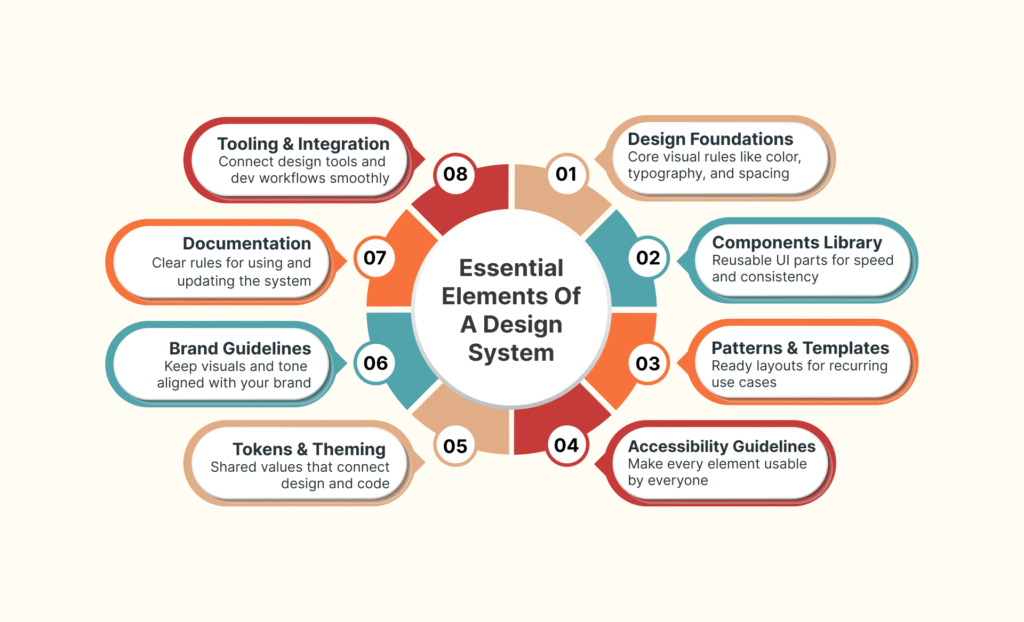
Start small and validate with real projects
Rushing to build comprehensive design systems without validation typically leads to failure. The most successful approaches begin modestly, focusing on components that address immediate needs. Building from scratch allows tailoring to unique requirements, whereas adopting existing frameworks provides faster implementation. Ultimately, there’s no universal answer—your choice depends on team capabilities, bandwidth, and long-term goals.
Throughout development, consider:
- Starting with your most-used components rather than building everything at once
- Testing components in actual projects before formalizing them
- Mapping design elements to existing code components wherever possible
This strategic alignment ensures you’re building upon foundations already established by developers rather than creating parallel systems.
Embed accessibility and documentation from day one
Accessibility cannot be an afterthought. When creating your design system, incorporate elements like font sizes, color contrast, and proper component labeling from the beginning. Clear guidelines for both designers and developers lay the foundation for inclusive products that serve all users.
Documentation serves as the bridge between creation and implementation. Beyond showing how components look, comprehensive documentation must explain proper usage and accessibility features. Create semantic naming conventions reflecting component function rather than appearance—for example, “color-warning” instead of descriptive visual terms. This shared language connects design and development teams, ensuring design decisions flow seamlessly into implementation.
Create feedback loops between design and dev
Design systems thrive on continuous improvement driven by regular feedback. Establish processes where designers and developers regularly review component performance and suggest refinements. Product teams should organize retrospective sprints to analyze progress and implement necessary improvements across the entire team.
Seeking diverse perspectives strengthens your system immeasurably. Include not just designers but also developers, product managers, and other stakeholders who bring valuable insights on technical feasibility and maintenance considerations. These cross-functional perspectives help ensure your design system meets the needs of your entire product team rather than serving just one discipline.
Feedback loops represent the immune system of your design system—they identify weaknesses before they become systemic failures and continuously strengthen the foundation as your product evolves.
Making the value visible before failure
Proactively measuring a design system’s impact prevents its value from remaining hidden until failure occurs. By quantifying its benefits, teams can justify continued investment and improve adoption across the organization.
Track usage metrics and adoption rates
Measuring usage metrics provides critical insights into design system effectiveness. Component usage data reveals which elements function as workhorses and which might need improvement. Teams should monitor:
- Component insertion frequency (some systems see 100,000+ component insertions monthly)
- Documentation page visits and search queries
- Detachment rates that signal potential issues or enhancement needs
Tracking adoption across departments helps identify areas needing additional support. Higher adoption typically correlates with greater consistency and efficiency throughout your product.
Showcase time saved and reduced bugs
Quantifying time savings presents perhaps the most compelling case for design systems. For larger tasks, design systems can reduce work time by up to 45%, whereas simpler tasks see 80% improvement—turning 14-15 hour projects into 2.5-hour completions. Even at minimum efficiency, studies show design systems cut required time by over 50%, from 73 to 36 hours.
Use A/B testing to validate design system impact
A/B testing offers a powerful method for demonstrating design system value through direct comparison. This approach lets you quantitatively measure how design system implementations affect conversion rates, time-on-page, or bounce rates. A/B tests work particularly well for individual components, allowing teams to isolate specific variables while keeping everything else constant, thereby proving the system’s direct impact on business metrics.
Conclusion
Design systems serve as the invisible foundation that powers consistent user experiences across digital products. Nevertheless, their true value often becomes apparent only when inconsistencies emerge or development processes break down. Throughout this article, we’ve explored how these systems silently enable teams to build cohesive experiences while reducing decision fatigue and streamlining workflows.
The distinction between merely collecting design files and creating a true design system lies primarily in governance, maintenance, and organizational adoption. Design systems fail silently when treated as side projects rather than critical infrastructure deserving dedicated resources and clear ownership.
Teams launching design system initiatives should start small, validate with real projects, and build feedback loops between designers and developers. This approach prevents the common pitfall of overbuilding before confirming actual usage needs. Additionally, embedding accessibility standards from day one ensures inclusive experiences while proper documentation bridges the gap between design intentions and implementation.
Rather than waiting for failure to reveal a design system’s importance, teams must proactively measure its impact through usage metrics, adoption rates, and time savings. A/B testing further validates how design system implementations directly affect business outcomes, therefore making the invisible value visible before problems arise.
Design systems ultimately represent more than technical solutions—they embody a fundamental shift in how teams collaborate across disciplines. When properly implemented and maintained, they eliminate redundant work, reduce inconsistencies, and allow teams to focus on solving unique problems rather than recreating basic elements. The organizations that treat design systems as evolving products rather than one-time projects will continue to benefit from their silent but powerful impact on both user experience and development efficiency.
Key Takeaways
Design systems are the invisible infrastructure that powers consistent digital experiences, but their true value only becomes apparent when they break down. Understanding how to build and maintain these systems properly can save organizations from costly failures and development delays.
• Design systems fail silently when treated as side projects – Without dedicated ownership and resources, even well-intentioned systems gradually drift into irrelevance and abandonment.
• Start small and validate with real projects before scaling – Building comprehensive systems without validation leads to overengineering; focus on your most-used components first.
• Embed accessibility and documentation from day one – These aren’t afterthoughts but foundational elements that prevent costly redesigns and ensure inclusive user experiences.
• Track measurable impact to make invisible value visible – Monitor usage metrics, time savings, and adoption rates to demonstrate business value before failure reveals the system’s importance.
• Create feedback loops between design and development teams – Cross-functional collaboration and regular retrospectives strengthen the system and prevent it from becoming disconnected from real needs.
The most successful design systems aren’t just collections of components—they’re living products that require ongoing maintenance, clear governance, and organizational commitment to truly deliver on their promise of consistency and efficiency.
FAQs
Q1. Why is the value of a design system often overlooked until problems arise?
The value of a design system is often invisible because it silently enables consistency and efficiency. Its true worth becomes apparent only when inconsistencies emerge or development processes break down, revealing the system’s critical role in maintaining a cohesive user experience.
Q2. How does a design system differ from a style guide or component library?
A design system is more comprehensive, encompassing not just visual elements but also interaction patterns, design principles, and documentation. While a style guide focuses on visual references and a component library houses reusable UI elements, a design system provides a holistic framework for creating cohesive product experiences.
Q3. What are common reasons design systems fail?
Design systems often fail due to lack of clear ownership, treatment as side projects rather than critical infrastructure, overbuilding before validating real usage needs, and absence of proper governance or contribution models. These factors can lead to gradual abandonment and irrelevance.
Q4. How can teams measure the impact of a design system?
Teams can quantify a design system’s impact by tracking usage metrics, adoption rates across departments, time saved in development, and reduction in design inconsistencies. A/B testing can also validate how design system implementations directly affect business outcomes like conversion rates or user engagement.
Q5. What steps can organizations take to build a resilient design system?
To build a resilient design system, organizations should start small and validate with real projects, embed accessibility and documentation from the beginning, create feedback loops between design and development teams, and establish clear governance and ownership. Regular evaluation and iteration based on actual usage and team feedback are crucial for long-term success.


